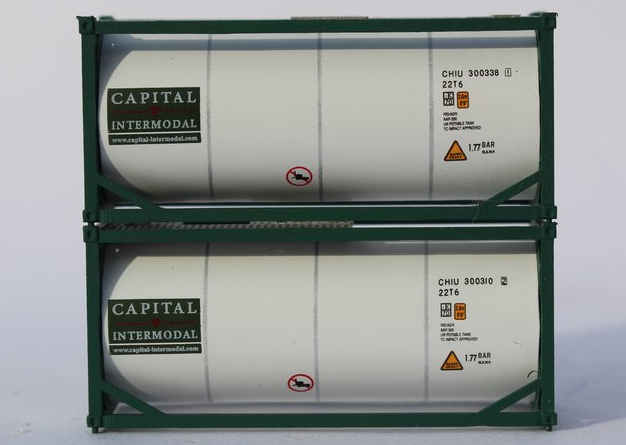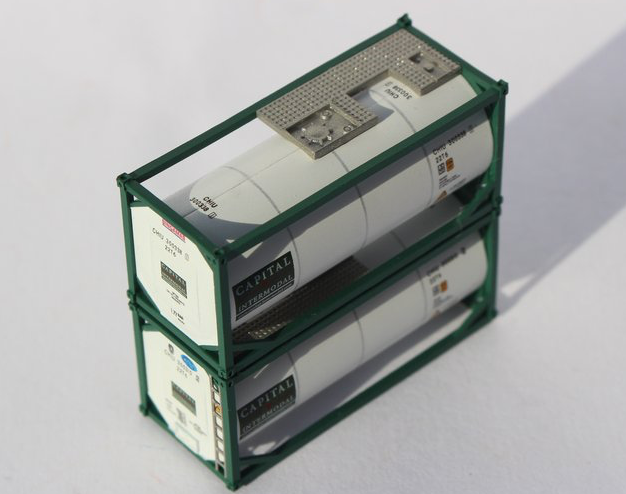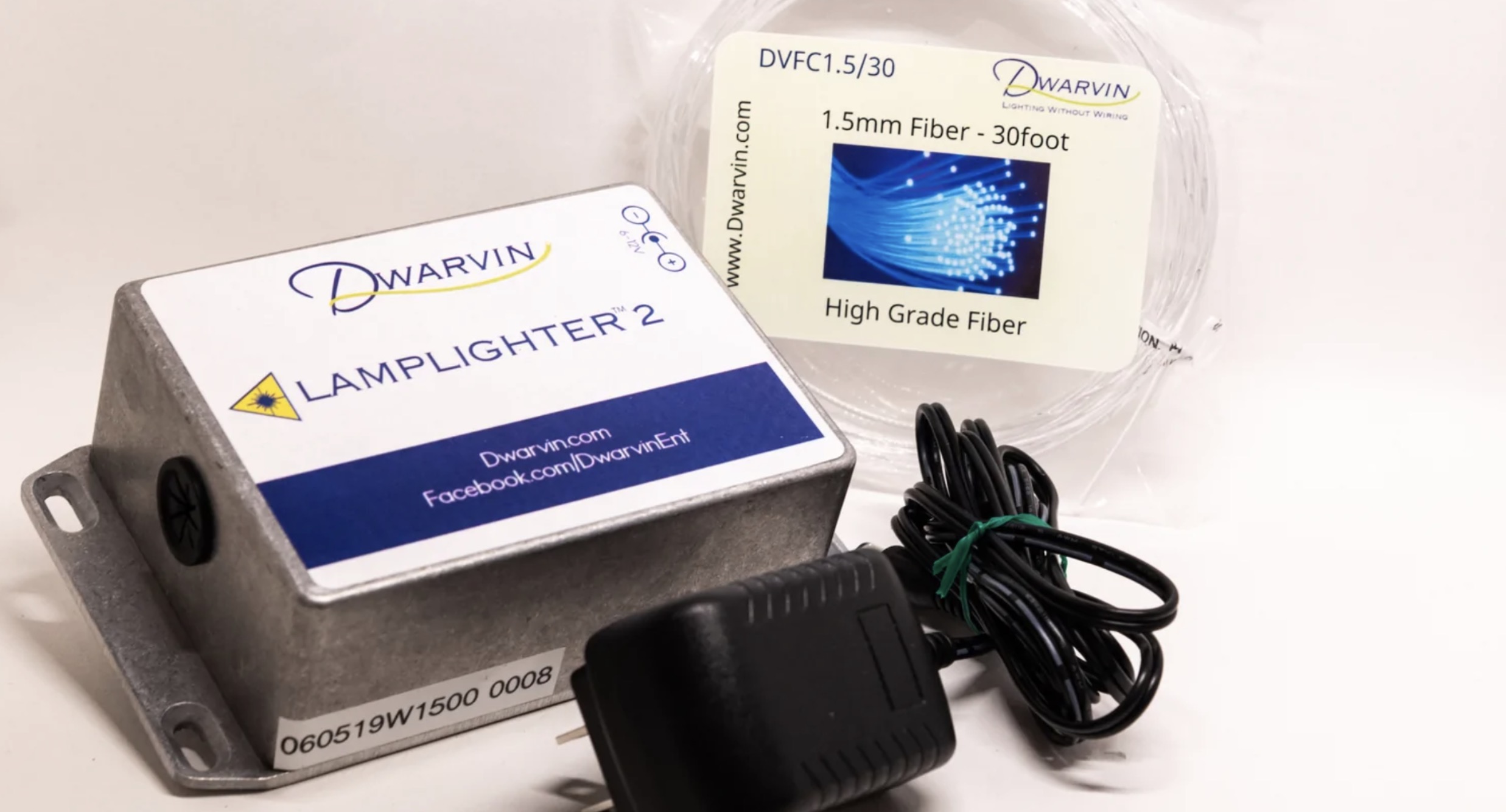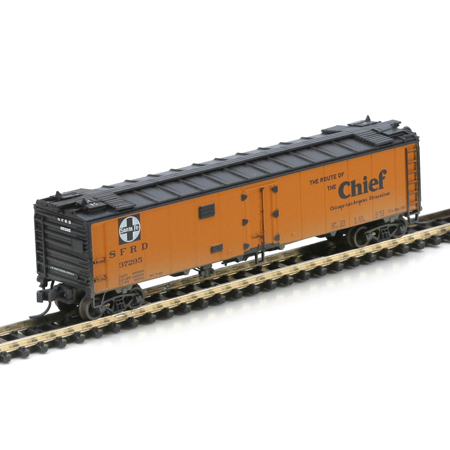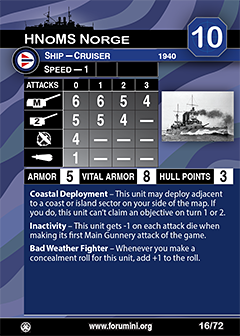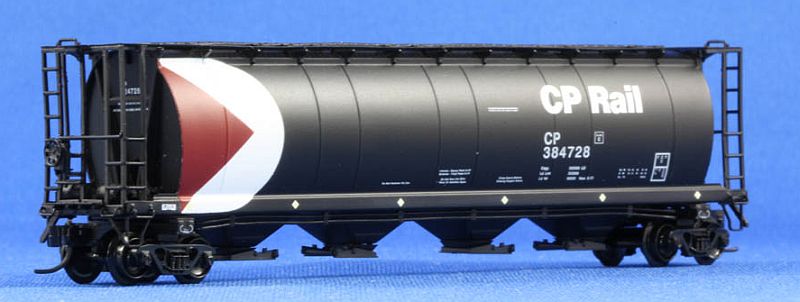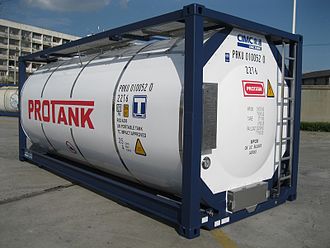Model Information: These are also finely detailed, delicate miniatures with scales frames and details. Rules for Tank container transport provides for transport in the bottom of well cars, and on flatcars. If the tank container has hazardous liquid it should Not have another container stacked on top of it (look for Hazard label). If non-hazardous, other containers can be stacked on top. Tank containers do not ship double stacked in the Top position.
Model Features:
IBC 'PIN' and holes for stacking
Multiple walkway configurations to match prototypes
Etched metal end ladder
When required - mechanical unit (Heat / Cool) and Placard/Tool box as per prototype picture.
Precise printing as per prototype
These do not have a magnet on bottom, as they do not ship stacked on top of another container.
Model Features:
IBC 'PIN' and holes for stacking
Multiple walkway configurations to match prototypes
Etched metal end ladder
When required - mechanical unit (Heat / Cool) and Placard/Tool box as per prototype picture.
Precise printing as per prototype
These do not have a magnet on bottom, as they do not ship stacked on top of another container.
Prototype History: A tank container is built to the ISO standards, making it suitable for different modes of transportation. Both hazardous and non-hazardous products can be transported in tank containers.
The tank container concept was also employed in Europe by Bob Fossey, an engineer who worked for Williams Fairclough in London. They improved on the 1950s framed American elliptical container tanks, oft noted carrying specified USA engine oils for the UK’s MoD aircraft built in Preston, Lancashire.
In 1964 Fairclough made a swap body tank for combined transport by truck and train, but not yet constructed according to ISO standards.
In 1966, commercial production began and one year later the first tank container to ISO dimensions was developed. The first mass-produced tank containers were purchased by Trafpak, a part of Pakhoed.
Rules for Tank container transport provides for transport in the bottom of well cars, and on flatcars: if the tank container has hazardous liquid it should Not have another container stacked on top of it (look for Hazard label). If non-hazardous, other containers can be stacked on top. Tank containers do not ship double stacked in the Top position.
The tank container concept was also employed in Europe by Bob Fossey, an engineer who worked for Williams Fairclough in London. They improved on the 1950s framed American elliptical container tanks, oft noted carrying specified USA engine oils for the UK’s MoD aircraft built in Preston, Lancashire.
In 1964 Fairclough made a swap body tank for combined transport by truck and train, but not yet constructed according to ISO standards.
In 1966, commercial production began and one year later the first tank container to ISO dimensions was developed. The first mass-produced tank containers were purchased by Trafpak, a part of Pakhoed.
Rules for Tank container transport provides for transport in the bottom of well cars, and on flatcars: if the tank container has hazardous liquid it should Not have another container stacked on top of it (look for Hazard label). If non-hazardous, other containers can be stacked on top. Tank containers do not ship double stacked in the Top position.
Road Name History: Capital Intermodal is a market leader in the supply and financing of a wide range of special containers and associated container equipment. This includes:
Global dry freight "marine" specials with ISO specifications for international transport used by Intercontinental Shipping Lines, Transport Companies, Shippers and Logistics Specialists for example Flat Racks, Open Tops, Side Doors, Bulkers, Bitumen Carriers, Lubricant Transporter, Tank Containers, Car Carrying Containers
Regional specials for intermodal transport in USA, Australia and Europe used by Short-sea Shipping Lines, Rail Operators, Logistics Providers and Road Haulage Operators for example 40' & 45' Palletwides, Swap Bodies, 45' PW Curtain Sides, 45' PW Reefers, 48's, Chassis, Roll Trailers.
Global dry freight "marine" specials with ISO specifications for international transport used by Intercontinental Shipping Lines, Transport Companies, Shippers and Logistics Specialists for example Flat Racks, Open Tops, Side Doors, Bulkers, Bitumen Carriers, Lubricant Transporter, Tank Containers, Car Carrying Containers
Regional specials for intermodal transport in USA, Australia and Europe used by Short-sea Shipping Lines, Rail Operators, Logistics Providers and Road Haulage Operators for example 40' & 45' Palletwides, Swap Bodies, 45' PW Curtain Sides, 45' PW Reefers, 48's, Chassis, Roll Trailers.
Brand/Importer Information: Now featuring our new line of 1:160 scale models. Developed using the latest in global technology & CAD systems, these New 2017 tooled models feature IBC connecting pins AND our Magnetic connecting system, and are decorated with detailed prototype printing. Our JTC container series of models offer Multiple door styles and variants to match prototypes. The First release is a 'Rib-style' corrugated side Canvas/Open top container, Now In Stock. Our second release is the more common 'wave' corrugation sides version, expected January 2018. Both are New to N scale. Release styles 3 & 4 will be around March 2018, and will be 2 of the most popular container styles in use. Please read our 'Latest News' section for updates. Thank You for visiting. New Facebook page: www.facebook.com/JTCmodeltrains
Item created by: CNW400 on 2021-01-08 16:18:47
If you see errors or missing data in this entry, please feel free to log in and edit it. Anyone with a Gmail account can log in instantly.
If you see errors or missing data in this entry, please feel free to log in and edit it. Anyone with a Gmail account can log in instantly.


